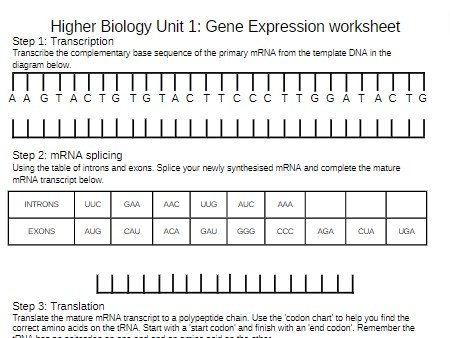Unlocking Gene Expression Secrets: Worksheet Inside

Delving into the realm of biology, one of the most profound and intricate areas of study is gene expression. Gene expression refers to the process by which information from a gene is used to produce functional products, such as proteins, which in turn influence the traits of an organism. This journey from DNA to RNA to protein is not only a cornerstone of molecular biology but also pivotal for understanding how cells function, how organisms develop, and how diseases can occur when this process is disturbed. In this post, we'll explore the essentials of gene expression, break down the process step-by-step, and provide a handy worksheet to help students and enthusiasts alike better grasp this complex topic.
What is Gene Expression?

Gene expression is the process by which the genetic instructions encoded in DNA are converted into a functional product like a protein. This involves several key steps:
- Transcription: The first stage where the DNA sequence is copied into RNA by the enzyme RNA polymerase.
- RNA Processing: The initial RNA transcript, known as pre-mRNA in eukaryotes, undergoes modification including capping, splicing, and polyadenylation.
- Translation: mRNA is translated into amino acids to form proteins with the help of ribosomes and tRNA.
Transcription in Detail

Transcription is the first step in gene expression and can be summarized as:
- Initiation: RNA polymerase, along with transcription factors, binds to the promoter region of the gene.
- Elongation: The RNA polymerase moves along the DNA template, unwinding and synthesizing the RNA strand.
- Termination: Transcription ends when the RNA polymerase reaches a termination sequence, and the RNA is released.
RNA Processing: An Essential Step

In eukaryotic cells, RNA processing is crucial. Here are the steps:
- Capping: A modified guanine nucleotide is added to the 5' end of the RNA.
- Splicing: Introns are removed, and exons are joined to form mature mRNA.
- Polyadenylation: A poly(A) tail is added to the 3' end, which stabilizes the mRNA and aids in its export from the nucleus.
💡 Note: RNA processing enhances mRNA stability and efficiency in translation.
Translation: From mRNA to Protein

Translation takes place in the cytoplasm, where ribosomes translate mRNA into proteins:
- Initiation: The ribosome assembles around the start codon of the mRNA.
- Elongation: tRNAs bring amino acids to the ribosome, where they are linked by peptide bonds.
- Termination: Translation stops at a stop codon, releasing the protein.
| Step | Process |
|---|---|
| Transcription | RNA synthesis from DNA |
| RNA Processing | Intron removal, capping, polyadenylation |
| Translation | Protein synthesis from mRNA |

⚠️ Note: Errors in any of these steps can lead to genetic disorders or cancer.
Worksheet on Gene Expression

To further your understanding of gene expression, here is a worksheet designed to guide you through the key concepts:
- Define gene expression and explain why it's important.
- Describe the three main steps of gene expression.
- List the RNA modifications in eukaryotic cells.
- Draw or describe the process of transcription.
- Explain what happens during translation.
- Identify three potential points where gene expression can be regulated.
💡 Note: This worksheet is meant for educational purposes to reinforce understanding of gene expression.
In summary, gene expression is a multifaceted process essential for cellular function and organismal development. We’ve explored transcription, RNA processing, and translation in detail, providing a worksheet for further study. Understanding these steps not only enlightens us about life’s complexity but also underscores the potential for medical interventions in cases where gene expression goes awry.
What happens if there are errors in gene expression?

+
Errors in gene expression can lead to a variety of conditions, from mild developmental anomalies to severe diseases like cancer. Improper splicing, for example, can produce nonfunctional proteins or alter protein function significantly.
How is gene expression regulated?

+
Gene expression is regulated at multiple levels including chromatin remodeling, transcriptional control, RNA processing, and translation. This includes activation or repression by transcription factors, RNA interference, and post-translational modifications.
Can gene expression be altered by the environment?

+
Yes, environmental factors can significantly influence gene expression. This is known as epigenetics, where external conditions can modify gene expression without changing the DNA sequence itself.
What is the role of RNA in gene expression?

+
RNA, particularly mRNA, serves as the template for protein synthesis in translation. Different types of RNA (tRNA, rRNA) also play vital roles in translation and gene regulation.
How does understanding gene expression benefit biotechnology?

+
Understanding gene expression allows for targeted gene therapies, gene silencing for disease treatment, and the development of genetically modified organisms for various applications in agriculture, pharmaceuticals, and beyond.